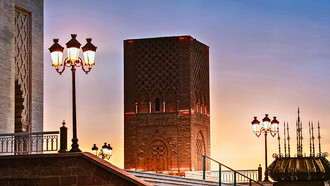The first time I came to Copenhagen, I was charmed by its tidy efficiency and candlelit cafés. On this second visit, I was looking for something different: not just hygge, but stillness. A kind of considered luxury that doesn’t shout. Nobis Hotel delivered exactly that.
Housed in a 1903 neoclassical building that once belonged to the Royal Danish Academy of Music, the Nobis is quiet in tone and taste. There’s no spectacle. Just chevron parquet floors, Danish stone, and a palette drawn from the winter sky. The interiors, designed by Wingårdhs, favour restraint over drama. Even the check-in process feels like a soft welcome rather than a performance. No small talk. No script. Just presence.
The room itself was elegant and almost monastic. We stayed in a junior suite tucked into the corner of the building. The historic windows were positioned unusually high. You had to stretch to catch a glimpse of the rooftops, which made the room feel private, introspective, and unusually calm. It was less about the view and more about the atmosphere. Even the Wi-Fi seemed content not to make a fuss. There was no flatscreen television dominating the space, no glowing switches or voice assistants waiting to be summoned. It was all considered, all quiet.
But we didn’t come to Copenhagen to stay cloistered. The city has a way of drawing you out.
One morning, we set off on a canal cruise that wound through the city’s waterways, ducking under old bridges and gliding past converted warehouses, waterside cafés, and grand civic buildings. From the water, Copenhagen shows its layers. Modern architecture stands beside seventeenth-century gables. Brick and glass alternate like a kind of rhythm. Even the harsh lines of concrete seem softened by the city’s sense of proportion. It’s a place that’s been styled without being self-conscious. The skyline doesn’t try to impress. It just makes sense.
Naturally, we passed the Little Mermaid. There she was, perched on her rock, smaller than you expect but undeniably poised. Like many icons—the Mona Lisa, the Hollywood Sign—she’s both overexposed and strangely moving. Her expression is unreadable. Her gaze is fixed on the horizon. She doesn’t demand your attention. She simply holds it.
The next day, we took the train north to Helsingør. The journey itself felt designed to slow you down. Pastel-painted homes blurred by, then forest, then glimpses of water. Eventually, the train dropped us in a postcard-perfect harbour town dominated by Kronborg Castle. Better known to the world as Hamlet’s Castle, it rises from the sea with a kind of stern nobility. Inside, the halls are vast and echoing, the battlements wide and wind-swept. It doesn’t matter whether Shakespeare ever stood there. The atmosphere makes it easy to believe he might have. There’s a theatrical stillness to the place. A sense that tragedy and precision can coexist.
Returning to Copenhagen, we wandered the Designmuseum, which is both airy and exacting, and dipped in and out of concept stores that make minimalism feel seductive rather than austere. At lunch, we found ourselves at Schønnemann, one of the oldest smørrebrød restaurants in the city. There’s something deeply satisfying about a meal that doesn’t try to surprise you. The rye was dense and fragrant, the herring sharp and cold, the schnapps properly bracing. I ordered smoked eel with scrambled egg and chives. It arrived exactly as described. And it was perfect.
Copenhagen is a city that rewards attention. It’s not loud. But it’s rich in detail, in texture, in intentionality. The public spaces feel designed to make you feel calm rather than excited. The cafes don’t hustle you to turn the table. You are allowed to linger. You are invited to notice things. I kept thinking how rare that is: to travel without feeling chased by your own itinerary.
Each night, we returned to the Nobis. And each night, the room seemed to exhale a little deeper. The bathroom, clad in Swedish marble, looked like a set from a Bergman film. Stark, serious, and precise. It invited you to slow down. To step barefoot onto the heated floor. To sit in the silence and hear it fully. Even the lighting felt deliberate. No downlighters. Just soft, directional warmth from carefully placed lamps. You begin to notice your own breathing.
In the morning, we’d make our way down to the conservatory for breakfast. The light poured in gently. There was no buffet theatre. Just platters of smoked salmon, bowls of ripe berries, just-warmed bread, and a green juice that tasted like something a farmer, not a mixologist, had prepared. The second cup of coffee always arrived just before I thought to ask. No one hurried us. The tables were spaced generously. The staff moved with ease. You felt looked after, but never watched.
There are hotels that dazzle and hotels that restore. Nobis does the latter, and does it beautifully. It’s a place where every detail is quiet, but none of it is accidental. A place that lets the city sing while offering you a room in which to rest, reset, and return to yourself.
Would I stay again? Without question. And next time, I’ll bring a little stool, just tall enough to see more of those rooftops.















